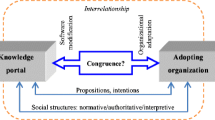Abstract
This paper examines the relationship between perceived ‘knowledge transfer’ effectiveness of different information channels for computer-aided software engineering (CASE) technology and CASE innovation diffusion. Specifically, the knowledge transfer effectiveness of seven information sources and channels is assessed. CASE innovation behaviour is modelled using three stages: initiation, adoption and implementation. Three types of CASE innovations are examined: two technical process innovations and one administrative innovation. Data for the empirical study were collected through a large-scale national survey of senior IS managers. A total of 405 usable responses were received. The perceived knowledge transfer effectiveness of the information sources and channels is associated differently with the initiation, adoption and implementation phases of the innovation process. Further, these associations are not uniform across the three categories of CASE innovations. The study has implications for how knowledge barriers can be alleviated during the CASE diffusion process.
Similar content being viewed by others
Author information
Authors and Affiliations
Rights and permissions
About this article
Cite this article
Rai, A. External information source and channel effectiveness and the diffusion of CASE innovations: an empirical study. Eur J Inf Syst 4, 93–102 (1995). https://doi.org/10.1057/ejis.1995.11
Published:
Issue Date:
DOI: https://doi.org/10.1057/ejis.1995.11




